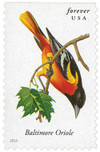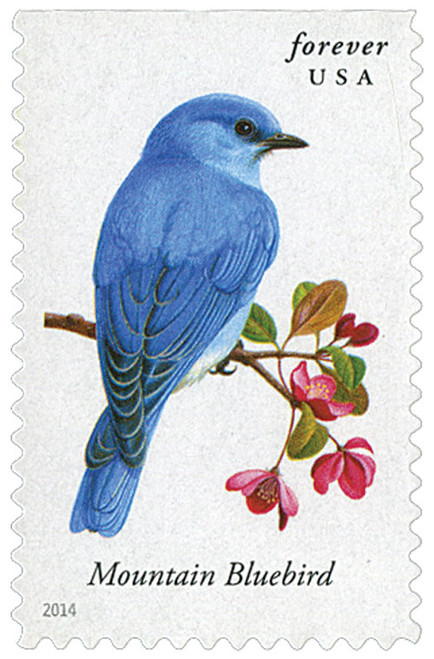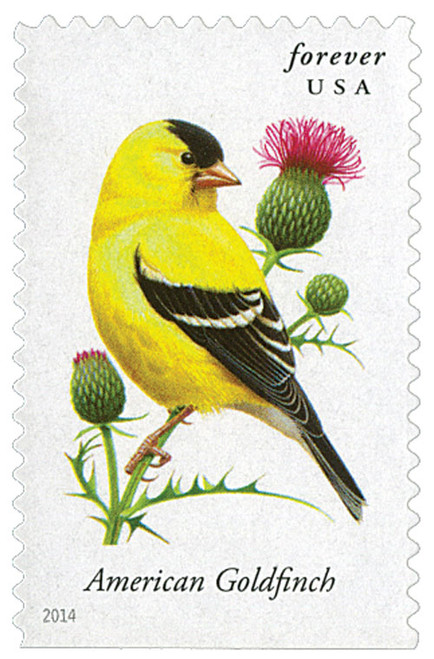
# 4886 - 2014 First-Class Forever Stamp - Songbirds: Baltimore Oriole
US #4886
2014 Baltimore Oriole – Songbirds
- Pictures a Baltimore Oriole
- One of 10 stamps picturing different species of songbird
Stamp Category: Commemorative
Set: Songbirds
Value: 49¢ First Class Mail Rate (Forever)
First Day of Issue: April 5, 2014
First Day City: Dallas, Texas
Quantity Issued: 400,000,000
Printed by: Ashton Potter (USA) Ltd.
Printing Method: Offset
Format: Double-sided Booklets of 20
Tagging: Nonphosphored Type III, Overall Tagged
Why the stamp was issued: To commemorate the Baltimore Oriole and its unique song.
About the stamp design: Pictures a painting of a Baltimore Oriole perched on a maple tree branch. Artwork by Robert Giusti. The stamp also includes the species’ common name.
First Day City: In addition to the Dallas, Texas, First Day of Issue city, there was also a First Day of Sale ceremony held at the Philadelphia National Stamp Exposition in Oaks, Pennsylvania. They offered two different pictorial postmarks: one from Oaks and one from nearby Audubon, Pennsylvania. The pictorial cancels were designed by the American First Day Cover Society.
About the Songbirds set: Issued to commemorate the many species of songbirds that call America home and fill the air with the sounds of their unique tunes. Includes 10 different designs, each picturing a different species of songbird and its’ common name: western meadowlark, mountain bluebird, western tanager, painted bunting, Baltimore oriole, evening grosbeak, scarlet tanager, rose-breasted grosbeak, American goldfinch, and white-throated sparrow. In addition to the birds themselves, the stamps also picture different plants (often found in the birds’ natural habitats) acting as perches. Designs were created from paintings by Robert Giusti.
History the stamp represents: During spring and summer, the Baltimore oriole is abundant throughout the Eastern United States and Canada. It is most often heard whistling its songs far above, but its bright orange plumage can sometimes be seen as it hops acrobatically through the high, leafy tree branches.
The oriole has a varied diet consisting of a wide array of insects, including several pest species. This dietar trait makes he bird welcome on many farms. However, the oriole more often enjoys nectar from dark, ripe fruits and can itself be considered a pest to fruit growers.
While the Baltimore oriole is an avid forager of fruits and insects, it will also frequent backyard hummingbird feeders. The bird is used to humans and is comfortable nesting in backyard trees, making access to manmade nectar reservoirs convenient. It doesn’t mind that the feeders are sized for much smaller birds. Luckily, many people now offer larger feeders designed with more substantial perches specifically for the oriole.
The Baltimore oriole, like Maryland’s largest city, is named after the state’s founder, the Second Baron Baltimore of England. The bright orange and black colors of the bird are the same as those on the baron’s family coat of arms.
US #4886
2014 Baltimore Oriole – Songbirds
- Pictures a Baltimore Oriole
- One of 10 stamps picturing different species of songbird
Stamp Category: Commemorative
Set: Songbirds
Value: 49¢ First Class Mail Rate (Forever)
First Day of Issue: April 5, 2014
First Day City: Dallas, Texas
Quantity Issued: 400,000,000
Printed by: Ashton Potter (USA) Ltd.
Printing Method: Offset
Format: Double-sided Booklets of 20
Tagging: Nonphosphored Type III, Overall Tagged
Why the stamp was issued: To commemorate the Baltimore Oriole and its unique song.
About the stamp design: Pictures a painting of a Baltimore Oriole perched on a maple tree branch. Artwork by Robert Giusti. The stamp also includes the species’ common name.
First Day City: In addition to the Dallas, Texas, First Day of Issue city, there was also a First Day of Sale ceremony held at the Philadelphia National Stamp Exposition in Oaks, Pennsylvania. They offered two different pictorial postmarks: one from Oaks and one from nearby Audubon, Pennsylvania. The pictorial cancels were designed by the American First Day Cover Society.
About the Songbirds set: Issued to commemorate the many species of songbirds that call America home and fill the air with the sounds of their unique tunes. Includes 10 different designs, each picturing a different species of songbird and its’ common name: western meadowlark, mountain bluebird, western tanager, painted bunting, Baltimore oriole, evening grosbeak, scarlet tanager, rose-breasted grosbeak, American goldfinch, and white-throated sparrow. In addition to the birds themselves, the stamps also picture different plants (often found in the birds’ natural habitats) acting as perches. Designs were created from paintings by Robert Giusti.
History the stamp represents: During spring and summer, the Baltimore oriole is abundant throughout the Eastern United States and Canada. It is most often heard whistling its songs far above, but its bright orange plumage can sometimes be seen as it hops acrobatically through the high, leafy tree branches.
The oriole has a varied diet consisting of a wide array of insects, including several pest species. This dietar trait makes he bird welcome on many farms. However, the oriole more often enjoys nectar from dark, ripe fruits and can itself be considered a pest to fruit growers.
While the Baltimore oriole is an avid forager of fruits and insects, it will also frequent backyard hummingbird feeders. The bird is used to humans and is comfortable nesting in backyard trees, making access to manmade nectar reservoirs convenient. It doesn’t mind that the feeders are sized for much smaller birds. Luckily, many people now offer larger feeders designed with more substantial perches specifically for the oriole.
The Baltimore oriole, like Maryland’s largest city, is named after the state’s founder, the Second Baron Baltimore of England. The bright orange and black colors of the bird are the same as those on the baron’s family coat of arms.














